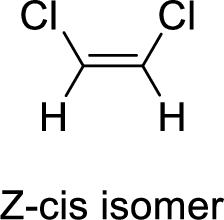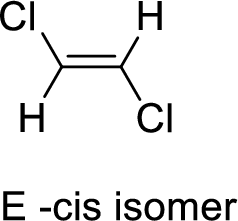
Chemistry: The Molecular Science
5th Edition
ISBN: 9781285199047
Author: John W. Moore, Conrad L. Stanitski
Publisher: Cengage Learning
expand_more
expand_more
format_list_bulleted
Concept explainers
Question
Chapter 6.5, Problem 6.5CE
Interpretation Introduction
Interpretation:
The cis isomer and the trans isomer of the maleic acid and fumaric acid has to be identified.
Concept Introduction:
It is under the class ofgeometric isomer. It exists inalkenes(organic molecules which have double bonds). Whentwo similar or higher priority groups are attached to the carbon on the same side,it is termed asCisisomer and when it is attached to theopposite sideit is called asTransisomer.
Cis isomers are termed as z-isomer and Tran’s isomers are termed as E-isomer.


Expert Solution & Answer
Want to see the full answer?
Check out a sample textbook solution
Students have asked these similar questions
For example, alanine is a chiral amino acid that has two enantiomers: (+)-alanine and (-)-alanine.
These two are optical isomers.
NH2
NH2
4.
One of the most important properties of chiral
molecules in solution is their effect on plane-
polarized light, this effect is called optical activity.
-C H
2
COOH
HOOC
CH
When an enantiomer rotates a plane-polarized light
in the positive direction or clockwise, it is
dextrorotary (+ or d), while for a negative direction
or counterclockwise, it is levorotary (- or l)
(+)-Alanine
(-)-Alanine
Alanine is a chiral amino acid that has two
enantiomers: (+)-alanine and ()-alanine. These two are
optical isomers.
Proteins are made of amino acids. Given below is the
structure of an example of amino acid. What are the two
functional groups found in all amino acids?
H
CH3
|
T
+
H-N-C-C
T
H H
O carboxylate group and methyl group
O ammonium group and methyl group
O methyl group and thiol group
O aldehyde group and ketone group
O ammonium group and carboxylate group
O
If you rotate the hydrogen atoms to a different position in a a model of C2H6 by turning about the central C—C bond, do you get different structural (or constitutional) isomers of C2H5Cl?
Chapter 6 Solutions
Chemistry: The Molecular Science
Ch. 6.2 - Write Lewis structures for (a) NF3, (b) N2H4, and...Ch. 6.3 - Prob. 6.1ECh. 6.3 - Prob. 6.2PSPCh. 6.4 - Prob. 6.2CECh. 6.4 - Write Lewis structures for (a) nitrosyl ion, NO+;...Ch. 6.5 - Prob. 6.4CECh. 6.5 - Prob. 6.5CECh. 6.5 - Prob. 6.4PSPCh. 6.6 - Prob. 6.5PSPCh. 6.6 - Use Equation 6.1 and values from Table 6.2 to...
Ch. 6.6 - Prob. 6.6CECh. 6.7 - Prob. 6.7PSPCh. 6.7 - Prob. 6.7CECh. 6.8 - Prob. 6.8PSPCh. 6.9 - Prob. 6.9PSPCh. 6.9 - Prob. 6.9CECh. 6.10 - Prob. 6.10PSPCh. 6.11 - Prob. 6.10ECh. 6.11 - Prob. 6.11ECh. 6.11 - Prob. 1CECh. 6.11 - Prob. 2CECh. 6.12 - Repeat Problem-Solving Example 6.11, but use N2...Ch. 6.12 - Use MO theory to predict the bond order and the...Ch. 6 - Prob. 1QRTCh. 6 - Prob. 2QRTCh. 6 - Prob. 3QRTCh. 6 - Prob. 4QRTCh. 6 - Prob. 5QRTCh. 6 - Prob. 6QRTCh. 6 - Which of these molecules have an odd number of...Ch. 6 - Prob. 8QRTCh. 6 - Prob. 9QRTCh. 6 - Prob. 10QRTCh. 6 - Prob. 11QRTCh. 6 - Prob. 12QRTCh. 6 - Explain in your own words why the energy of two H...Ch. 6 - Prob. 14QRTCh. 6 - Prob. 15QRTCh. 6 - Prob. 16QRTCh. 6 - Prob. 17QRTCh. 6 - Prob. 18QRTCh. 6 - Prob. 19QRTCh. 6 -
Write Lewis structures for
tetracyanoethene,...Ch. 6 - Prob. 21QRTCh. 6 - Prob. 22QRTCh. 6 - Prob. 23QRTCh. 6 - Prob. 24QRTCh. 6 - Prob. 25QRTCh. 6 - Prob. 26QRTCh. 6 - Prob. 27QRTCh. 6 - Prob. 28QRTCh. 6 - Prob. 29QRTCh. 6 - For each pair of bonds, predict which is the...Ch. 6 - Prob. 31QRTCh. 6 - Prob. 32QRTCh. 6 - Which bond requires more energy to break: the...Ch. 6 -
Estimate ΔrH° for forming 2 mol ammonia from...Ch. 6 - Prob. 35QRTCh. 6 - Light of appropriate wavelength can break chemical...Ch. 6 - Prob. 37QRTCh. 6 - Prob. 38QRTCh. 6 - Prob. 39QRTCh. 6 - Acrolein is the starting material for certain...Ch. 6 - Prob. 41QRTCh. 6 - Prob. 42QRTCh. 6 - Write the correct Lewis structure and assign a...Ch. 6 - Prob. 44QRTCh. 6 - Prob. 45QRTCh. 6 - Two Lewis structures can be written for nitrosyl...Ch. 6 - Prob. 47QRTCh. 6 - Prob. 48QRTCh. 6 - Prob. 49QRTCh. 6 - Prob. 50QRTCh. 6 - Several Lewis structures can be written for...Ch. 6 - Prob. 52QRTCh. 6 - Prob. 53QRTCh. 6 - Prob. 54QRTCh. 6 - Prob. 55QRTCh. 6 - Draw resonance structures for each of these ions:...Ch. 6 - Three known isomers exist of N2CO, with the atoms...Ch. 6 - Write the Lewis structure for (a) BrF5 (b) IF5 (c)...Ch. 6 - Write the Lewis structure for
BrF3
XeF4
Ch. 6 - Prob. 60QRTCh. 6 - Prob. 61QRTCh. 6 - Prob. 62QRTCh. 6 - All carbon-to-carbon bond lengths are identical in...Ch. 6 - Prob. 64QRTCh. 6 - Prob. 65QRTCh. 6 - Prob. 66QRTCh. 6 - Prob. 67QRTCh. 6 - Prob. 68QRTCh. 6 - Prob. 69QRTCh. 6 - Prob. 70QRTCh. 6 - Using just a periodic table (not a table of...Ch. 6 - The CBr bond length in CBr4 is 191 pm; the BrBr...Ch. 6 - Prob. 73QRTCh. 6 -
Acrylonitrile is the building block of the...Ch. 6 - Prob. 75QRTCh. 6 - Write Lewis structures for (a) SCl2 (b) Cl3+ (c)...Ch. 6 - Prob. 77QRTCh. 6 - Prob. 78QRTCh. 6 - A student drew this incorrect Lewis structure for...Ch. 6 - This Lewis structure for SF5+ is drawn...Ch. 6 - Tribromide, Br3, and triiodide, I3, ions are often...Ch. 6 - Explain why nonmetal atoms in Period 3 and beyond...Ch. 6 - Prob. 83QRTCh. 6 - Prob. 84QRTCh. 6 - Prob. 85QRTCh. 6 - Prob. 86QRTCh. 6 - Which of these molecules is least likely to exist:...Ch. 6 - Write the Lewis structure for nitrosyl fluoride,...Ch. 6 - Prob. 91QRTCh. 6 - Methylcyanoacrylate is the active ingredient in...Ch. 6 - Aspirin is made from salicylic acid, which has...Ch. 6 - Prob. 94QRTCh. 6 - Prob. 95QRTCh. 6 - Prob. 96QRTCh. 6 - Prob. 97QRTCh. 6 - Prob. 98QRTCh. 6 - Nitrosyl azide, N4O, is a pale yellow solid first...Ch. 6 - Write the Lewis structures for (a) (Cl2PN)3 (b)...Ch. 6 - Nitrous oxide, N2O, is a linear molecule that has...Ch. 6 - The azide ion, N3, has three resonance hybrid...Ch. 6 - Hydrazoic acid, HN3, has three resonance hybrid...Ch. 6 - Prob. 104QRTCh. 6 - Experimental evidence indicates the existence of...Ch. 6 - Prob. 106QRTCh. 6 - Prob. 107QRTCh. 6 - Pipeline, the active ingredient in black pepper,...Ch. 6 - Sulfur and oxygen form a series of 2 anions...Ch. 6 - Prob. 110QRTCh. 6 - Prob. 111QRTCh. 6 - Prob. 112QRTCh. 6 - Prob. 113QRTCh. 6 - Prob. 114QRTCh. 6 - Prob. 115QRTCh. 6 - Prob. 116QRTCh. 6 - Prob. 117QRTCh. 6 - Prob. 118QRTCh. 6 - Prob. 6.ACPCh. 6 - Prob. 6.BCPCh. 6 - Prob. 6.CCP
Knowledge Booster
Learn more about
Need a deep-dive on the concept behind this application? Look no further. Learn more about this topic, chemistry and related others by exploring similar questions and additional content below.Similar questions
- Do you predict the product to be the cis isomer, the trans isomer, or a mixture of cis and trans isomers? Explain.arrow_forwardWhich one of these compounds are cis-trans isomers? Br F a b Br Br darrow_forward||| O NAMING AND DRAWING ORGANIC MOLECULES Interpreting condensed chemical structures Use this condensed chemical structure to complete the table below. 0 NH₂ - CH — C — OH | CH3 The condensed chemical structure of alanine Some facts about the alanine molecule: number of carbon-carbon single (C - C) bonds: number of carbon-hydrogen single (C-H) bonds: number of oxygen-hydrogen single (O - H) bonds: number of nitrogen-hydrogen single (N - H) bonds: number of lone pairs: X Ś 0 ☐ 1 D 503 Jessarrow_forward
- How do the properties of cis-trans isomers differ from one another? cis and trans isomers have identical physical properites, whereas their chemical properties differ cis and trans isomers have identical chemical properites, whereas their physical properties differ cis and trans isomers have identical physical and chemical properties cis and trans isomers have distinct physical and chemical propertiesarrow_forwardIsomers are different compounds that have the same molecular formula. If the atoms are connected in different ways, they are called constitutional or structural isomers. Geometric isomers are a type of isomer where the order of the atoms in the two compounds is the same but their arrangement in space is different. The most common types of geometric isomers are cis- and trans- isomers. PART 5: Constitutional/Structural Isomers Draw (using any method you wish) and give the IUPAC name for any four isomers with the molecular formula C6H12Brz. Structure: - Br CH₂ сна CH₂CH CH CH₂ CH₂ Br. Name: bromo-3 methyl peature Name: Structure: Structure: Name: Structure: comors Name:arrow_forwardHow many chiral canters do we have in the structure?arrow_forward
- Consider C2 H6 O3. How many isomers can be drawn that have three O H groups?arrow_forwardExplain what geometric isomers are. Use appropriate terminology and include the following in your explanation: Cis vs. trans isomers. Relative energy levels. Give an example of a pair of geometric isomers. Don’t use Maleic/Fumaric!arrow_forwardLinoleic acid is an essential fatty acid found in many vegetable oils, such as soy, peanut, and cottonseed. A key structural feature of the molecule is the cis orientation around its two double bonds, where R1 and R2 represent two different groups that form the rest of the molecule. (a) How many different compounds are possible, changing only the cis-trans arrangements around these two double bonds? (b) How many are possible for a similar compound with three double bonds?arrow_forward
arrow_back_ios
SEE MORE QUESTIONS
arrow_forward_ios
Recommended textbooks for you
 Chemistry: The Molecular ScienceChemistryISBN:9781285199047Author:John W. Moore, Conrad L. StanitskiPublisher:Cengage Learning
Chemistry: The Molecular ScienceChemistryISBN:9781285199047Author:John W. Moore, Conrad L. StanitskiPublisher:Cengage Learning Chemistry & Chemical ReactivityChemistryISBN:9781337399074Author:John C. Kotz, Paul M. Treichel, John Townsend, David TreichelPublisher:Cengage Learning
Chemistry & Chemical ReactivityChemistryISBN:9781337399074Author:John C. Kotz, Paul M. Treichel, John Townsend, David TreichelPublisher:Cengage Learning Chemistry & Chemical ReactivityChemistryISBN:9781133949640Author:John C. Kotz, Paul M. Treichel, John Townsend, David TreichelPublisher:Cengage Learning
Chemistry & Chemical ReactivityChemistryISBN:9781133949640Author:John C. Kotz, Paul M. Treichel, John Townsend, David TreichelPublisher:Cengage Learning- Chemistry: Matter and ChangeChemistryISBN:9780078746376Author:Dinah Zike, Laurel Dingrando, Nicholas Hainen, Cheryl WistromPublisher:Glencoe/McGraw-Hill School Pub Co
 Chemistry: Principles and ReactionsChemistryISBN:9781305079373Author:William L. Masterton, Cecile N. HurleyPublisher:Cengage Learning
Chemistry: Principles and ReactionsChemistryISBN:9781305079373Author:William L. Masterton, Cecile N. HurleyPublisher:Cengage Learning

Chemistry: The Molecular Science
Chemistry
ISBN:9781285199047
Author:John W. Moore, Conrad L. Stanitski
Publisher:Cengage Learning

Chemistry & Chemical Reactivity
Chemistry
ISBN:9781337399074
Author:John C. Kotz, Paul M. Treichel, John Townsend, David Treichel
Publisher:Cengage Learning

Chemistry & Chemical Reactivity
Chemistry
ISBN:9781133949640
Author:John C. Kotz, Paul M. Treichel, John Townsend, David Treichel
Publisher:Cengage Learning

Chemistry: Matter and Change
Chemistry
ISBN:9780078746376
Author:Dinah Zike, Laurel Dingrando, Nicholas Hainen, Cheryl Wistrom
Publisher:Glencoe/McGraw-Hill School Pub Co

Chemistry: Principles and Reactions
Chemistry
ISBN:9781305079373
Author:William L. Masterton, Cecile N. Hurley
Publisher:Cengage Learning
